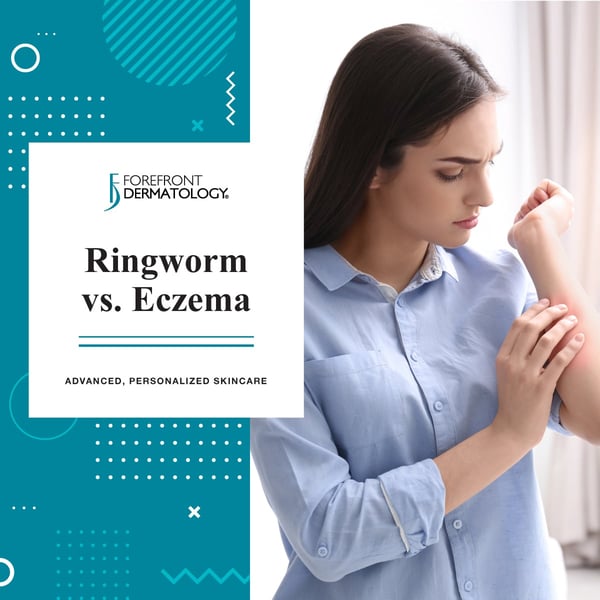
Dry, itchy skin conditions can leave you scratching your head wondering what exactly is going on. There are two skin conditions, nummular eczema, a form of eczema, and ringworm that can cause closely similar rashes, but knowing the difference is very important.
What is Nummular Eczema?
Nummular eczema is a condition in which people develop red or brown areas on their skin that are coin-shaped or oval, similar to the shape of ringworm. These spots or patches can appear on the arms, hands, legs, or torso. The skin appears dry and may have a burning or itching feeling. According to the National Eczema Association, nummular eczema most commonly affects men, usually between the ages of 55 and 65 years old. If women experience the condition, they typically notice it between the ages of 13 and 25 years old. Doctors do not know exactly what causes nummular eczema, but some triggers and risk factors may include dry skin from cold weather, some topical creams, history of atopic eczema and injuries to the skin.
What is Ringworm?
According to Dr. Giacomo Maggiolino, board-certified dermatologist with Forefront Dermatology, “Ringworm is a skin infection caused by a fungus. The name signifies the visual sign of this rash which includes a ring-shaped pattern that features a raised and scaly border.” Ringworm has the ability to occur anywhere on your body. Ringworm can happen to anyone, anywhere. It is not a regional problem. Your chances increase though if you live in a tropical area, spend time in hot and humid weather, or sweat heavily. It is also more common for people who play contact sports including wrestling and football.
Ringworm and Eczema: How they appear and how to tell the difference
Both nummular eczema and ringworm appear as a red rash in a ring or coin shape. Both patches can appear dry and itchy and can grow over time and appear in clusters. While it may seem easy enough to self-diagnosis, you should see your local board-certified dermatologist to get proper diagnosis and treatment. Your dermatologist may need to take a tissue sample to confirm their diagnosis.
Treatment for Ringworm vs Eczema
Ringworm is an extremely contagious skin infection, and it is important that you prevent spreading it to others. Without treatment, the rash tends to grow and cover a larger area or possibly infect other areas of your body. If you suspect that you may have ringworm, start by applying antifungal cream, ointment or spray for up to 4 weeks. If it persists or begin to cover a larger portion of the body, visit your local dermatologist to receive a stronger prescription cream or pill. Nummular eczema on the other hand requires a more proactive approach to prevent flare-ups and relieve symptoms while your body slowly recovers. It is important to use gentle soaps, fragrance-free moisturizers, keep rooms in your home cool and moist with a humidifier and wear fabrics such as cotton to reduce skin irritation. If your nummular eczema is effecting your life, your dermatologist may prescribe topical or oral corticosteroids or recommend phototherapy, a treatment that involves exposing the skin to UV light. If your nummular eczema becomes infected, your dermatologist may also prescribe topical or oral antibiotics.
Skin Struggles?
At Forefront Dermatology, we know that life is all about the moments when you don’t need us. That’s why we’re here for all the moments when you do. We offer comprehensive and compassionate care for all skin conditions and create customized treatment plans for all ages – even the tiniest of patients! Find a dermatologist near you today.





